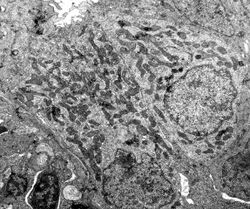Biology:Ionocyte
An ionocyte (formerly called a chloride cell) is a mitochondrion-rich cell within ionoregulatory organs of animals, such as teleost fish gill, insect Malpighian tubules, crustacean gills, antennal glands and maxillary glands, and copepod Crusalis organs.[1] These cells contribute to the maintenance of optimal osmotic, ionic, and acid-base levels within metazoans. In aquatic invertebrates, ionocytes perform the functions of both ion uptake and ion excretion.[2] In marine teleost fish, by expending energy to power the enzyme Na+/K+-ATPase and in coordination with other protein transporters, ionocytes pump excessive sodium and chloride ions against the concentration gradient into the ocean.[3][4][5] Conversely, freshwater teleost ionocytes use this low intracellular environment to attain sodium and chloride ions into the organism, and also against the concentration gradient.[3][5] In larval fishes with underdeveloped / developing gills, ionocytes can be found on the skin and fins.[6][7][8]
Mechanism of action
Marine teleost fishes consume large quantities of seawater to reduce osmotic dehydration.[9] The excess of ions absorbed from seawater is pumped out of the teleost fishes via the ionocytes.[9] These cells use active transport on the basolateral (internal) surface to accumulate chloride, which then diffuses out of the apical (external) surface and into the surrounding environment.[10] Such mitochondrion-rich cells are found in both the gill lamellae and filaments of teleost fish. Using a similar mechanism, freshwater teleost fish use these cells to take in salt from their dilute environment to prevent hyponatremia from water diffusing into the fish.[10] In the context of freshwater fish, ionocytes are often referred to as "mitochondria-rich cells", to emphasis their high density of mitochondria.[11]
See also
- Pulmonary ionocyte - a rare type of specialised cell that may regulate mucus viscosity in humans
References
- ↑ "The Legs Have It: In situ expression of ion transporters V-Type H+ ATPase and Na+/K+-ATPase in osmoregulating leg organs of the invading copepod Eurytemora affinis". Physiological and Biochemical Zoology 89 (3): 233-250. 2016. doi:10.1152/physrev.00050.200310.1086/686323.
- ↑ "Osmotic and ionic regulation in aquatic arthropods". Osmotic and Ionic Regulation: 165-230.
- ↑ Jump up to: 3.0 3.1 "The multifunctional fish gill: dominant site of gas exchange, osmoregulation, acid-base regulation, and excretion of nitrogenous waste". Physiological Reviews 85 (1): 97–177. January 2005. doi:10.1152/physrev.00050.2003. PMID 15618479.
- ↑ "Na(+), Cl(-), Ca(2+) and Zn(2+) transport by fish gills: retrospective review and prospective synthesis". The Journal of Experimental Zoology 293 (3): 264–83. August 2002. doi:10.1002/jez.10127. PMID 12115901.
- ↑ Jump up to: 5.0 5.1 "Molecular biology of major components of chloride cells". Comparative Biochemistry and Physiology. Part B, Biochemistry & Molecular Biology 136 (4): 593–620. December 2003. doi:10.1016/s1096-4959(03)00287-2. PMID 14662288.
- ↑ "The skin of fish as a transport epithelium: a review". Journal of Comparative Physiology B: Biochemical, Systemic, and Environmental Physiology 183 (7): 877–91. October 2013. doi:10.1007/s00360-013-0761-4. PMID 23660826.
- ↑ "Ontogenetic changes in cutaneous and branchial ionocytes and morphology in yellowfin tuna (Thunnus albacares) larvae". Journal of Comparative Physiology B: Biochemical, Systemic, and Environmental Physiology 189 (1): 81–95. February 2019. doi:10.1007/s00360-018-1187-9. PMID 30357584. https://escholarship.org/uc/item/9hn1c0qn.
- ↑ "Ontogeny of osmoregulation in postembryonic fish: a review". Comparative Biochemistry and Physiology. Part A, Molecular & Integrative Physiology 141 (4): 401–29. August 2005. doi:10.1016/j.cbpb.2005.01.013. PMID 16140237.
- ↑ Jump up to: 9.0 9.1 Allaby, Michael. "Chloride cells". A Dictionary of Zoology. http://www.encyclopedia.com/doc/1O8-chloridecells.html.
- ↑ Jump up to: 10.0 10.1 Wilmer, Pat; Stone, Graham; Johnston, Ian (2005). Environmental Physiology of Animals. Malden, MA: Blackwell. pp. 85. ISBN 978-1-4051-0724-2. https://archive.org/details/environmentalphy00will/page/85.
- ↑ Fernandes, M.N. (2019) "Respiration and Ionic-Osmoregulation". In: Formicki K and Kirschbaum F (Eds.) The Histology of Fishes pages 246–266, CRC Press. ISBN:9781498784481.
Further reading
- "Chloride cells and osmoregulation". Kidney International 49 (6): 1563–7. June 1996. doi:10.1038/ki.1996.225. PMID 8743455.
 |


